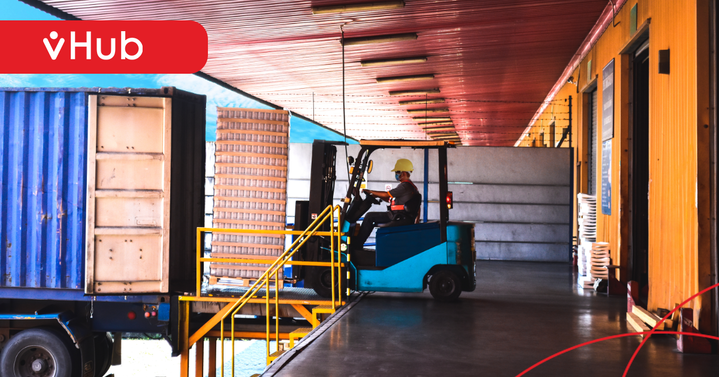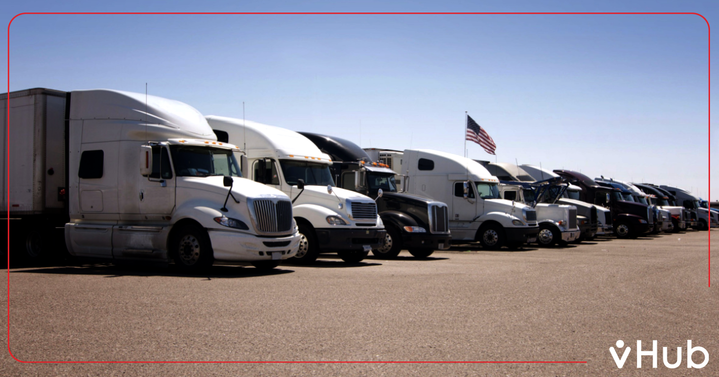There are over 21,000 warehouses in the U.S., employing over 1.78 million workers and responsible for storing goods of all kinds. A streamlined warehouse loading dock plays a crucial role in supporting an efficient transportation lane and reducing the cost of goods. For companies facing high inflation rates and a possible recession, cutting waste out of every process is essential for improving the bottom line.
Here is an article that considers how shippers and receivers can improve freight flows at the loading dock to reduce complications.
What is a Warehouse Loading Dock?
Every storage facility has an entrance point designed for loading and unloading goods from trucks. This entrance is typically a raised platform created to align with the height and width of most semi-truck trailers. The most common dock is 48–52 inches high and at least 8 feet wide to accommodate truck sizes.
The loading dock is one of the essential points of the warehouse because it controls the flow of goods and directly impacts profitability. A slow loading or unloading process can result in detention fees for drivers. A poor process can also increase damaged goods and injuries on the job. On the other hand, efficient loading dock operations can make your lanes more appealing to brokers, owner-operators, and carriers.
Tips to Optimize Warehouse Loading Dock Operations
Assessing your current loading dock process will help you consider where to make improvements. Here are seven ways you can optimize freight flows to reduce backlogs for your warehouse.
1. Establish Better Practices
Use a flow chart to determine where bottlenecks are occurring in your warehouse. These slowdowns occur because inventory comes in faster than workers can move items to the right place.
Bottlenecks create delayed shipments, unnecessary expenses, increased employee stress, and a heightened risk for incidents. Poor warehouse flow will also hurt morale, leading to frustrated workers, annoyed carriers, and unhappy customers.
Keep asking “why” problems occur until you get to the root cause. Once you figure out what’s slowing down your process, it’s important to change your approach. Help your team understand how new procedures and policies can help reduce these bottlenecks, making things easier for everyone.
2. Implement a Dock Scheduling Software
Are you running into issues of inconsistent dock traffic? If you go hours without a load and then have several come in simultaneously, you need a better scheduling process. A dock scheduling software allows carriers to book appointments so your team is ready as soon as they arrive. Better scheduling eliminates clustered arrivals, enabling you to reduce the backlog and even out the work schedule.
A good dock scheduling software can also include operating constraints that might affect loading — like your business hours, equipment, or labor resources. With better insights into your daily schedule, you’ll have a clear view of allocating time and staffing toward incoming or outgoing cargo.
3. Utilize the Right Equipment
Equipment like vehicle restraints, hydraulic dock levelers, and cargo transportation conveyors are another way to increase efficiency at your dock. The proper setup increases safety while speeding up the work process to reduce loading and unloading times. It’s important to consider your warehouse design and function, choosing the equipment that best supports your dock.
Dock bumpers, lifts, seals, and shelters are other examples of equipment that might support the transfer of goods at your warehouse. With truck designs continually changing,warehouses must adapt to provide the safest and most efficient setup possible to optimize their docks.
4. Be Aware and Learn the Possible Dangers
Around a quarter of all reported warehouse injuries occur on the loading docks. For every incident, there are hundreds of near misses as well. These accidents can cause increased expenses, delays, and worker turnover.
Understanding where these incidents are likely to occur can help your warehouse prioritize additional safety measures. According to ISHN, loading dock hazards primarily occur in five categories:
- Forklift Accidents
- Attention and Alertness
- Carbon Monoxide Poisoning
- Trailer Creep
- Slips, Trips, and Falls
Use the proper safety equipment, alerts, processes, and training to avoid these costly incidents.
5. Proper Ventilation & Fans
Without the proper airflow, the loading docks can be hazardous. The machines produce many fumes and dangerous chemicals at the dock. Keep your workers’ comfort and safety a top priority to reduce turnover, increase productivity, and reduce costs associated with workplace injuries.
The correct ventilation and fans will help keep the docks cooler with fresh air.
6. Use Modern Technology to Make Work Easier
Tools today are designed to support your warehouse managers and employees, helping them get more done than ever before. The right tools won’t replace your workers; they increase the capabilities of your workforce by helping streamline redundant jobs.
Consider how technology could increase your warehouse efficiency by increasing visibility, coordinating turn times, notifying you of arrivals, and more. You can automate stretch wrapping with a machine that does it for you. Mobile workstations on carts can help reduce foot traffic by making it possible to create labels, scan, weigh, and collect data right on the dock.
7. Use Trailer Visibility Technology
Most carriers don’t want to move an empty trailer because they lose money on every empty mile driven. As a shipper or receiver, you can reduce loading dock backlogs by helping your brokers, carriers, or owner-operators fill their trucks for the return trip.
The right software lets you see which trailers are suitable for nearby load-outs. Using vHub technology, you can automatically assess trailers to find out which ones are destined for a return trip in the right direction. These insights can help your logistics partners with lane enhancement while supporting an effective dock-clearing strategy.
Digitize Load-Outs & Direct Carrier Injections via a Marketplace to Turn Trailers Faster
If you are considering ways to expand your offerings, it might be time to create a digital marketplace for your carriers and brokers. Digitizing load-outs and direct carrier injections can help clear your docks while increasing profitability.
vHub allows you to establish your own marketplace with a white-label version. With an “offer now” approach, vHub enables your network to bid on repositions and identify opportunities to increase capacity. With optimized bi-directional reporting and live 360° maps, this platform will help asset owners and power-only companies connect to manage load outs. And, for every successful agreement, you get fees as the marketplace administrator.
Are you Interested in learning more? Our team would love to schedule a quick chat to discuss how vHub could help optimize your loading dock. Sign up for free, or contact us today!



